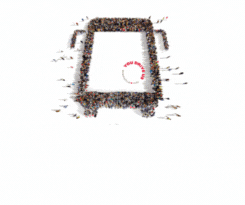
Photo: European-energy-campaign
Seventy cities join European energy campaign
13 January 2014
by Richard Forster
From its beginnings in the German city of Heidelberg, a campaign to get ordinary citizens in Europe to start saving energy and reduce their pollution has grown to 70 cities.
Called the ENGAGE campaign, the energy saving drive encourages people to create their own posters and initiatives to show how they as individuals can do their bit to help meet their city’s energy and climate objectives, according to Alix Bolle, spokesperson for Energy Cities, the association coordinating the campaign.
“Thanks to a user-friendly online tool, local authorities can create participant posters and showcasing the pledges of every participant demonstrates the power of combined energy-saving actions,” said Bolle. “The objective is also to develop efficient local communications campaigns which lead to tangible energy savings via the monitoring of participants’ energy consumption.” She said an estimated 10,000 participants were involved and that they had produced some 6,300 posters.
“By the end of 2013, on average, a citizen who took part in an ENGAGE campaign has reduced their annual CO2 emissions by 11 percent,” said Bolle.
She would not be drawn on which cities or towns are the dirtiest or the biggest polluters. “We believe seeking answers to this question would be missing the point. Improving quality of life–the real challenge faced by policy makers–will require more than individually addressing issues like pollution, which are just symptoms of a larger, systemic problem.”
She said that to make the lives of their citizens healthier and more comfortable, cities today had to think “cross-sector”, “multi-level” and “multi-stakeholder”.
“The issues at stake are too big to look for solutions through isolated action,” she added.
A prime example of the kind of work going on here comes from Heidelberg itself. The city has developed an online tool called the CO2 Mirror. It enables individuals to measure the greenhouse gas emissions from their daily activities and then set targets for cutting this down.
The CO2 Mirror is divided into four sections–nutrition, consumer behaviour, mobility and housing. Participants can monitor their emissions from, for example, central heating and transport, and analyse their daily habits as consumers and shoppers. They can even compare their results to the national average.
The tool helps people estimate how much energy they could save by making small lifestyle changes, such as with their travel or heating.
In a few clicks, they can quickly work out their personal carbon footprint for a period of up to five years, enabling them to set clear and realistic targets.
Since the ENGAGE poster campaign started in the Romanian town of Bistriţa in 2012, 100 people were closely monitored and able to show that they had achieved a 7 percent reduction of emissions, equivalent to 18.3 tonnes of CO2. Further afield, Turkish and Syrian refugee school children in the southern Turkish town of Gaziantep, have also taken up the campaign.







